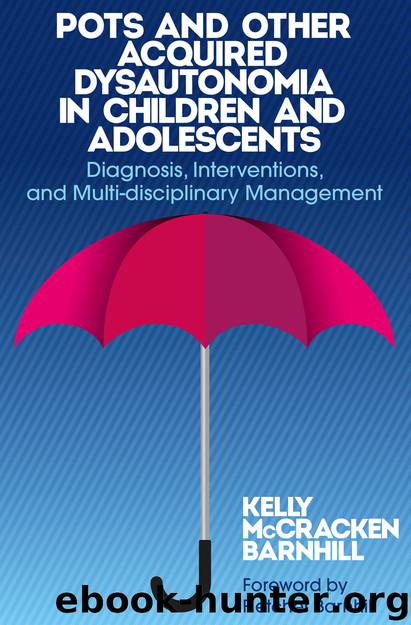POTS and Other Acquired Dysautonomia in Children and Adolescents by Kelly McCracken Barnhill

Author:Kelly McCracken Barnhill
Language: eng
Format: epub
ISBN: 9781784502010
Publisher: Jessica Kingsley Publishers
Published: 2016-05-26T16:00:00+00:00
What is the rationale for swimming and water-based exercise?
Starting in the water is also a good idea for those with somewhat stable health concerns who do not have access to aquatic therapy programs. Swimming is ideal because of the decreased load and horizontal positioning in the water to address ongoing orthostatic intolerance. Water-based activities as described above are also effective because the water creates pressure on a patient’s torso and lower limbs and this in turn helps blood return to the heart for recirculation. The blood vessels in the legs are compressed (much like with the use of compression stockings and support, which are also recommended for many patients) and this minimizes the impact of orthostatic intolerance. Many patients report that while attempting even a walk down the block is almost impossible, they are able to move their bodies well when in water.
Clearly, there are obvious precautions to consider and implement if initiating a water-based therapy or exercise program. A physical therapist is particularly important in the event of ongoing and uncontrollable syncope events. If this is a stable symptom, working in a pool that has a lifeguard along with a trainer or caregiver is another good option. Consider water temperature carefully, as working in highly heated pools can exacerbate symptoms of dysautonomia (particularly lightheadedness) and negate these positive steps toward improvement.
Patients with dysautonomia can also benefit from other exercises that do not cause or aggravate orthostatic stress. Activities such as simple stretching, some Pilates movements, and yoga are good initial options. Other reasonable choices for patients with an autonomic dysfunction diagnosis are the use of a recumbent bicycle or a rowing machine. Both allow the user to recline while still benefiting from the exercise the equipment offers.
Sample activity options are provided below, to encourage thinking about implementing exercise and movement in a daily plan for the patient. This is not a plan to be followed exactly, as that should be developed in conjunction with a practitioner who is knowledgeable regarding your child’s specific needs. However, these are reasonable and appropriate exercises to consider. This information is adapted from materials produced and provided by a number of entities, including the Aquatics Rehab Institute, the American Occupational/Physical Therapy Association, and the Texas Board of Occupational/Physical Therapy Examiners.
Download
This site does not store any files on its server. We only index and link to content provided by other sites. Please contact the content providers to delete copyright contents if any and email us, we'll remove relevant links or contents immediately.
| Anatomy | Bacteriology |
| Biochemistry | Biostatistics |
| Biotechnology | Cell Biology |
| Embryology | Epidemiology |
| Genetics | Histology |
| Immunology | Microbiology |
| Neuroanatomy | Nosology |
| Pathophysiology | Physiology |
| Virology |
Tuesdays with Morrie by Mitch Albom(4690)
Yoga Anatomy by Kaminoff Leslie(4306)
Science and Development of Muscle Hypertrophy by Brad Schoenfeld(4088)
Bodyweight Strength Training: 12 Weeks to Build Muscle and Burn Fat by Jay Cardiello(3913)
Introduction to Kinesiology by Shirl J. Hoffman(3725)
How Music Works by David Byrne(3187)
Sapiens and Homo Deus by Yuval Noah Harari(2987)
The Plant Paradox by Dr. Steven R. Gundry M.D(2547)
Churchill by Paul Johnson(2506)
Insomniac City by Bill Hayes(2497)
Coroner's Journal by Louis Cataldie(2432)
Hashimoto's Protocol by Izabella Wentz PharmD(2331)
The Chimp Paradox by Peters Dr Steve(2297)
The Universe Inside You by Brian Clegg(2097)
Don't Look Behind You by Lois Duncan(2079)
The Immune System Recovery Plan by Susan Blum(2027)
The Hot Zone by Richard Preston(1983)
Endure by Alex Hutchinson(1964)
Woman: An Intimate Geography by Natalie Angier(1882)
